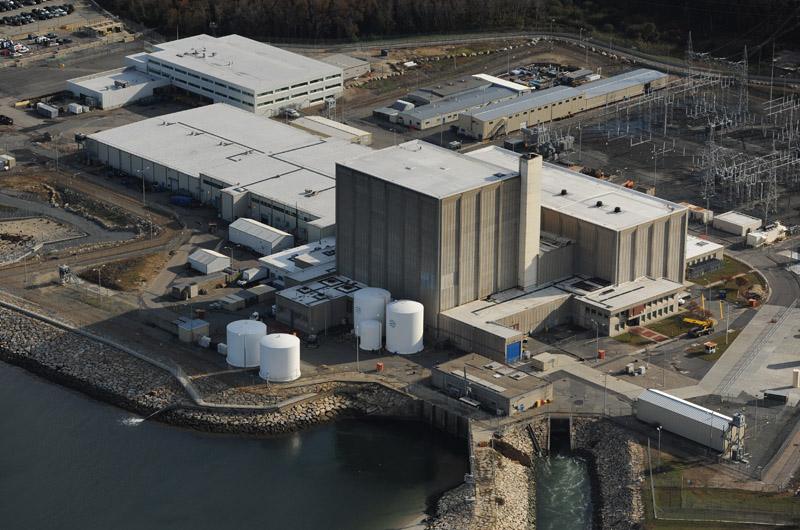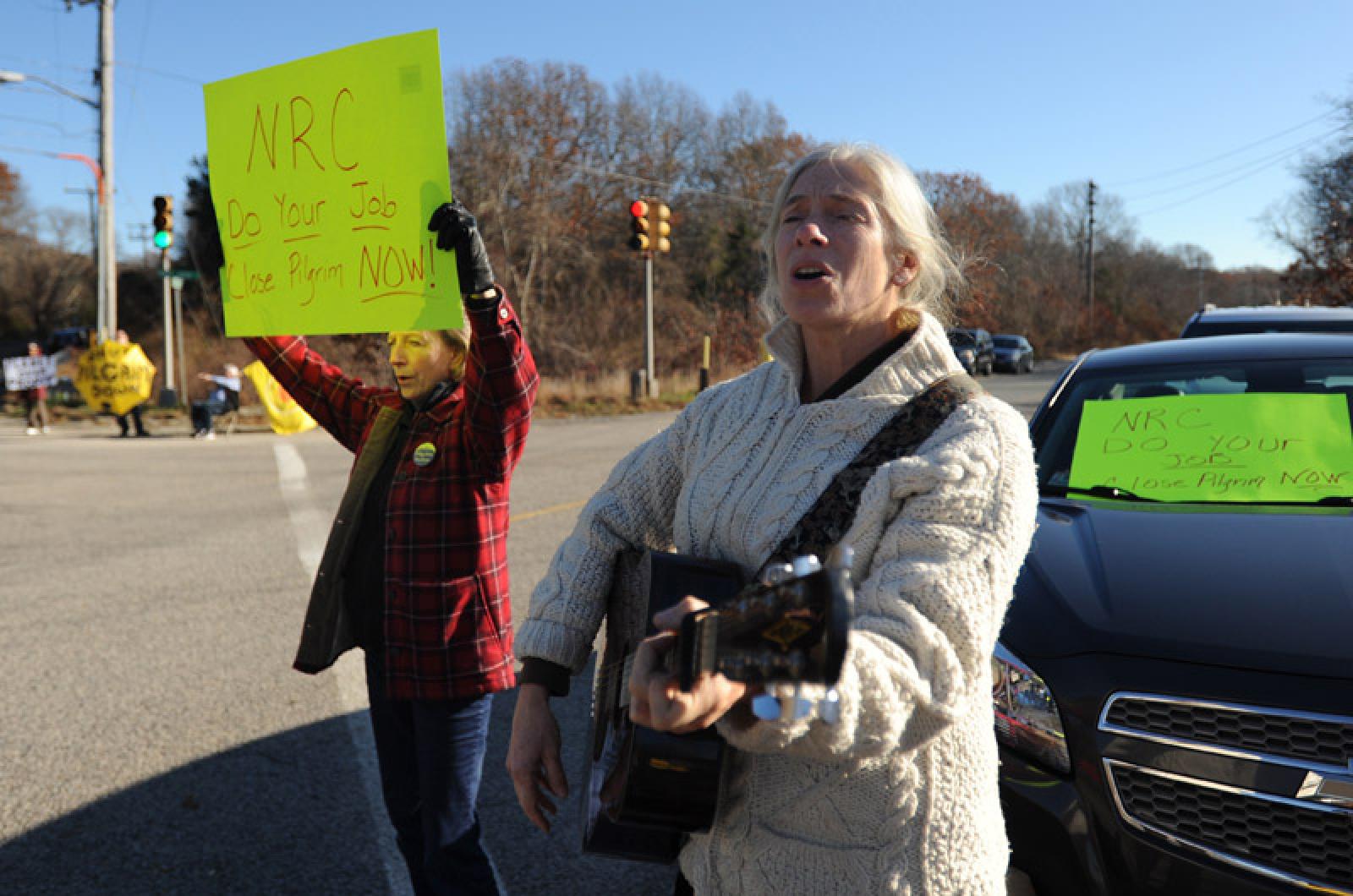The Nuclear Regulatory Commission has launched a far-reaching inspection of the Pilgrim Nuclear Power Plant in Plymouth, where a series of mishaps in recent years has raised public alarm and triggered heightened oversight by the federal agency.
A group of 20 nuclear experts from around the country arrived in Plymouth on Monday and will spend two weeks inspecting plant documents, procedures and equipment. Their arrival marks the third and largest phase in a heightened inspection process initiated last year after continued safety violations. Earlier phases in the inspection found minor violations related to water leakage and a revised maintenance procedure.
Inspectors plan to return after the holidays for a third week at the site, after which the NRC will issue a report and host a public meeting with plant owner Entergy.
Safety violations at Pilgrim, including a failure of plant workers to identify a problem with safety relief valves in 2013, and a forced shutdown during a winter storm last year, triggered an elevated oversight process that applies to all plants with such recurring safety issues.
Only two other plants in the country — Arkansas Nuclear One and Arkansas Nuclear Two, both owned by Entergy — have the same heightened level of oversight.
The NRC on its website notes weaknesses in “identifying and evaluating issues and completing corrective actions in a timely manner” at Pilgrim, which is slated to close in 2019.

The inspection comes against a backdrop of intense public concern surrounding the plant’s safety. In a letter to Gov. Charlie Baker in October, the Cape Cod National Seashore Advisory Council pressed for the plant’s immediate closure and for an evacuation plan that extends beyond greater Boston to include the Cape. The entire state delegation in October demanded that the NRC deny Entergy’s recent application to postpone compliance with a new safety procedure that was put in place following the disaster at Fukushima in 2011.
According to the Massachusetts Emergency Management Agency, which oversees evacuations in the state, the Cape and Islands would not be in immediate danger in the event of an accident at Pilgrim, so the short-term plan would be to shelter in place. But others have pointed out that the radioactive plume at Fukushima extended 50 miles from the plant and that a similar event here could easily affect the Cape and Islands.
Every town on the Cape, and most towns on the Vineyard, passed nonbinding resolutions two years ago asking for the plant’s closure.
Earlier this year, three members of the advocacy group Cape Downwinders were arrested at Gov. Charlie Baker’s statehouse offices, where they had gathered to deliver a letter calling for the plant’s closure. About 20 protesters from Boston and the Cape held signs outside Pilgrim on Monday as the inspection got underway.
Cape Downwinders co-founder and executive director Diane Turco cited a downward trend in recent years as Pilgrim slips from one safety rating to another, despite regular NRC inspections. She questioned the agency’s willingness to close the plant ahead of schedule, but believed it was the only logical course of action.
“How many inspections does it take to shut down a dangerous nuclear reactor that threatens over five million people?” she said, speaking to the Gazette by phone. “The NRC only needs to read its own reports.”
In a telephone press conference on Monday, NRC officials outlined the inspection process, which they said will focus largely on safety culture within the plant, along with a thorough review of documents and equipment. A primary goal is to determine how well the company has complied with safety procedures resulting from earlier problems. In addition, inspectors will evaluate Entergy’s preparation for the inspection itself, which has been underway at least since September.
Ray Lorson, regional director of reactor safety at the NRC who is overseeing the process, said the agency aims in general to uncover the root causes of safety lapses at plants where problems have persisted. “It’s important to understand why their own internal efforts to identify and fix problems before they arose to a level of significance were not successful,” he said. He added that only about 12 of the 100 nuclear plants nationwide have undergone the same type of inspection since the NRC implemented the process around 2000.
NRC experts will interview plant employees both one-on-one and in groups to evaluate the company’s safety culture, which Mr. Lorson described in part as encompassing “the willingness of plant employees to raise safety concerns without having to worry about reprisals.”
Inspection team leader Don Jackson, who is chief of operations for the region, said the safety culture component would likely take a different approach than the rest of the inspection by framing the matter more as a discussion than as a point-by-point assessment.
Overall, the process will involve close inspection of key equipment, along with the company’s maintenance, corrective action and risk-assessment procedures. In the event of a severe violation, Mr. Jackson said, the NRC could take immediate action. “Right now we do not have any immediate safety concerns and the plant is operating safely,” he added.
Ms. Turco painted a much more dire picture, however, citing a number of longstanding issues, including a containment structure that she said was too small to contain a severe accident, and an amendment to the plant’s operating license that allows it to far exceed its designed capacity for 880 spent fuel rods. (There are now more than 3,200 at the site.)
In 2012, the NRC granted a 20-year extension to the plant’s original 40-year operating license, despite opposition by state officials, advocacy groups and others. The agency has yet to deny such an extension.
NRC officials this week said they were unaware of a plant ever being closed as a result of an inspection, although they said it would be within the NRC’s power to require a shutdown as a result of their findings.
“We have a tremendous amount of independence with this inspection,” NRC public affairs officer Neil Sheehan said at the press conference, noting the participation of inspectors from around the country who are not directly involved with Pilgrim, and the observation of a state official.
The NRC officials were unaware of any change of course regarding the closure in 2019, but they said that process would not affect the inspection one way or the other. “Our focus here is to insure that the plant can operate safely until it reaches that point in time,” Mr. Lorson said.
Following the inspection, the plant could potentially return to a lower risk level, but Mr. Lorson said that process would take about two years.




Comments (2)
Comments
Comment policy »